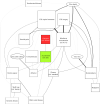Evaluation of risk factors for treatment failure in canine patients undergoing photoactivated chromophore for keratitis - corneal cross-linking (PACK-CXL): a retrospective study using additive bayesian network analysis
- PMID: 37919690
- PMCID: PMC10621152
- DOI: 10.1186/s12917-023-03779-x
Evaluation of risk factors for treatment failure in canine patients undergoing photoactivated chromophore for keratitis - corneal cross-linking (PACK-CXL): a retrospective study using additive bayesian network analysis
Abstract
Background: Infectious keratitis is a common ophthalmic condition in canine patients. Sequelae can include keratomalacia and corneal perforation, a vision threatening outcome. Photoactivated chromophore for keratitis - corneal cross-linking (PACK-CXL) is a non-surgical, adjunctive treatment method for infectious keratitis. The goal of this retrospective, multicenter study was to determine risk factors for treatment failure following PACK-CXL in canine patients suffering from suspected infectious keratitis. Medical records from four veterinary ophthalmology services were reviewed, and information related to patient demographics, ophthalmic findings, the PACK-CXL protocol used, and epithelialization time was collected and analyzed. Due to the potential for intervariable relationships, an additive Bayesian network (ABN) analysis was performed to evaluate these complex relationships.
Results: Records for 671 eyes (668 dogs) were included in the analysis. Based on the ABN, in the population included here, patients who underwent an accelerated PACK-CXL protocol were less likely to experience treatment failure versus patients treated with a slow protocol. Mutual dependencies between exposure variables were identified by ABN, which would have been overlooked using classical regression. Corneal re-epithelialization time was shortened following PACK-CXL combined with topical medical therapy compared to PACK-CXL alone.
Conclusions: No risk factors associated with treatment failure were identified in the population included in the present study. Canine patients may benefit from the use of accelerated PACK-CXL protocols, especially when combined with topical antibiotics and anti-collagenolytic therapy. The reasons for this apparent positive impact on treatment outcome remain unclear.
Keywords: Additive bayesian network; Canine; Corneal Ulcer; Directed acyclic graph; Infectious keratitis; PACK-CXL; Photoactivated chromophore for keratitis – corneal cross-linking.
© 2023. The Author(s).
Conflict of interest statement
The authors declare no competing interests.
Figures



References
-
- Gelatt KN. Veterinary Ophthalmology. New York: Wiley-Blackwell; 2021.
Publication types
MeSH terms
Substances
LinkOut - more resources
Full Text Sources

